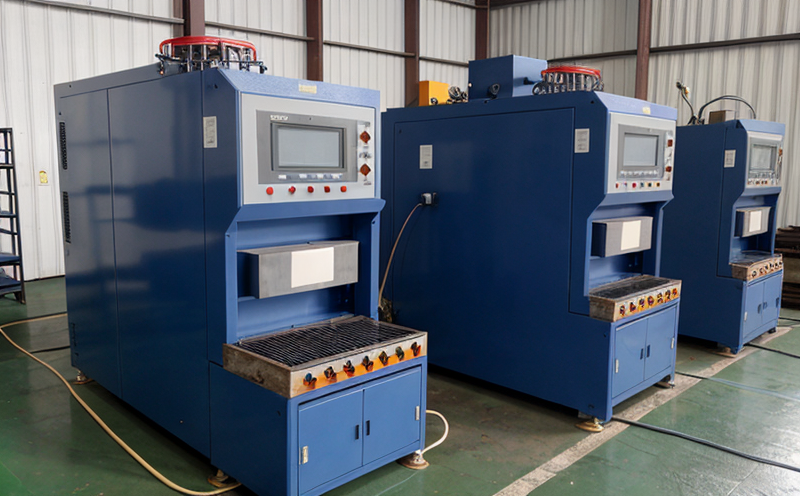ASTM D4327 Anion Content in Raw Chemical Inputs Testing
In industrial manufacturing and processing, raw chemical inputs play a critical role in ensuring product quality and operational efficiency. The anion content of these raw materials is a key factor that can influence the final product's performance and safety. ASTM D4327 provides a standardized method for determining the anion content in various raw chemical inputs used in industrial processes.
The standard specifies procedures for the quantitative determination of anions by ion chromatography. This test method helps manufacturers ensure compliance with quality standards set forth by industry regulations and internal specifications. By accurately measuring the anion content, companies can better control their production processes and avoid potential issues related to product performance or regulatory non-compliance.
ASTM D4327 is widely used across various sectors including chemical manufacturing, pharmaceuticals, electronics, and food processing. Its applicability spans raw materials such as solvents, reagents, catalysts, lubricants, and other chemicals used in industrial processes. The anion content can significantly affect the stability, reaction rate, and overall performance of these inputs.
The testing process typically involves sampling a representative portion of the raw chemical input according to specified procedures outlined in the standard. Once collected, the sample is prepared for analysis by ion chromatography, which separates different ions based on their affinity for stationary phases within the column. Detection limits depend on factors like sample volume and instrument sensitivity but generally range from parts per million (ppm) down to nanomolar levels.
It's important to note that deviations in anion content may lead to variations in product quality, stability issues, or even safety concerns depending upon how these raw materials interact within the broader production environment. Therefore, precise measurement and consistent monitoring are crucial for maintaining high standards throughout the supply chain.
The results obtained from ASTM D4327 testing provide valuable insights into potential risks associated with using certain types of raw chemicals. For instance, excessive levels of chloride anions could indicate contamination or improper storage conditions which might compromise product integrity. Conversely, low concentrations may suggest insufficient processing steps during manufacturing. Understanding these nuances allows manufacturers to make informed decisions about sourcing alternative suppliers or adjusting internal procedures.
By adhering to ASTM D4327 guidelines, organizations demonstrate their commitment to maintaining stringent quality controls and meeting regulatory requirements related to raw material specifications. This approach fosters trust among customers who rely on consistent product performance while also enhancing overall competitiveness within the marketplace.
Applied Standards
The ASTM D4327 standard is integral to ensuring accurate determination of anion content in various industrial applications involving raw chemical inputs. It draws upon internationally recognized methodologies such as ISO 8469-1, which deals with ion chromatography techniques for sample preparation and analysis.
- ISO 8469-1: This international standard provides guidance on preparing samples for ion chromatographic determinations of anions. It covers aspects like sampling procedures, sample preservation methods, and initial treatment steps prior to actual analysis.
- ASTM D7050: Another relevant ASTM document that complements D4327 by specifying additional details regarding the use of ion chromatography in determining anion concentrations. While primarily focused on water samples, its principles can be adapted for other liquid-based raw materials.
- EN ISO 19850: This European standard offers complementary information related to sample handling and preparation techniques applicable across multiple industries including those utilizing chemical inputs similar to what ASTM D4327 targets.
The combination of these standards ensures comprehensive coverage necessary for precise anion content measurement in diverse industrial settings. Compliance with such internationally recognized practices enhances credibility and reliability when presenting test results to stakeholders.
Quality and Reliability Assurance
Ensuring consistent quality and reliable performance is paramount in industrial manufacturing processes where even slight variations can have significant impacts on end-product characteristics. ASTM D4327 plays a vital role in this regard by providing robust analytical techniques that enable precise quantification of anion content.
The standard mandates rigorous laboratory practices aimed at minimizing errors throughout the testing process. These include proper sample collection, preservation methods to prevent degradation or contamination before analysis begins, and adherence to strict calibration protocols for instrumentation used during ion chromatography.
Accurate measurement is achieved through careful selection of appropriate columns and detectors tailored specifically towards detecting anions present in raw chemical inputs. Additionally, quality assurance measures encompass regular validation checks conducted against certified reference materials (CRMs) to verify analytical accuracy over time.
Moreover, laboratories employing ASTM D4327 must maintain accreditation according to recognized bodies like ISO/IEC 17025 or equivalent national standards. Such accreditations signify adherence to strict quality management systems designed to uphold credibility and trustworthiness among clients seeking reliable testing services.
Incorporating these stringent procedures into daily operations helps manufacturers achieve consistent results across different batches of raw materials, thereby reducing variability associated with raw chemical input quality. This ultimately leads to more predictable outcomes during production runs, contributing significantly towards meeting desired specifications for final products.





